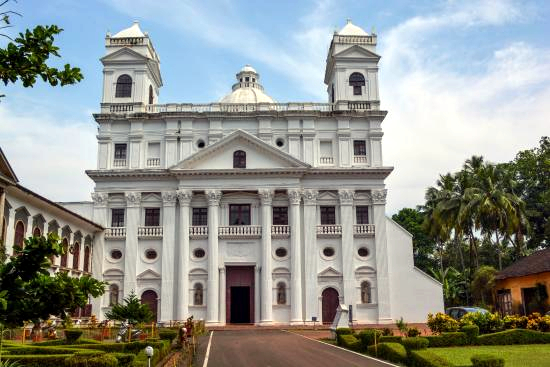
The Church dedicated to St Cajetan, undoubtedly one of the most beautiful churches of Old Goa, also known as the Church of Our Lady of Divine Providence, is situated along the road leading to the Divar ferry, northwest of Sé Cathedral.
It was constructed by the Theatine friars. The building is considered to have been modelled on St Peter’s Basilica in the Vatican, however some, like the 17th century traveller, Giovanni Francesco Gemelli Careti and Pietro Della Valle, say that it is modelled on the Sant’ Andrea della Valle, the seat of the Theatine order.
HISTORY
The Theatine congregation was established in 1524 by the Italian friars - St Cajetan of Thiene, Paolo Consiglieri, Bonifacio da Colle and Giovanni Pietro Carafa, the archbishop of Italy, who later became the Pope Paul IV.
In 1639, Pope Urban VIII, under the leadership of Dom Pietro di Avitabili, sent three Italian friars to Golconda to evangelise the people. Since they were not welcomed there by the rulers, they came to Goa in 1640. They settled themselves behind the college of St Paul, but later due to health reasons, they moved from there and bought a piece of land near Santa Monica convent. Here they wanted to set up a hospital but the Portuguese authorities here did not grant them permission since they were Italians and on March 13, 1645, the Portuguese viceroy Filipe Mascarenhas banished them from Goa.
Dom Pietro de Avitabili, their leader went to Lisboa and met the King John IV and convinced him of starting a hospital in Old Goa, as it would help in evangelisation work. The king granted the permission to the construction of a hospital here in 1650 and in 1655 also gave them permission to construct a church and a small convent near it, with the condition they would be under the control of the Portuguese there.
The friars decided to construct the church close to the banks of the river Mandovi. The construction was completed in 1661under the supervision of Italian architects, Calo Ferrarini and Francesco Maria Milazzo and it was dedicated to the Divine Providence, but it has been named after its founder, St Cajetan.
Touching the church is the convent of St Cajetan, built much later. In 1835, it was enlarged with the addition of two large halls. Other additions to it were done afterwards with the financial help from the government. At present, it houses the Pius X Institute of Pastoral Theology for the training of priests and the Liturgical office.
The Church is a dome like structure in the shape of a Greek cross; the Theatine motto “Seek ye first the Kingdom of God, and all these things shall be added unto you” (Mt. 6:33), is inscribed around the cupola in Latin. The interior of the dome has elaborate inscriptions from the gospel of St Mathew. It has four granite sculptures of Saints Peter, Paul, John the Evangelist and Matthew outside. The luminous walls inside are furnished with paintings which depict the scenes from the life of St Cajetan.
Directly under the dome of the church is a raised square platform on it is an altar and under it is a 72-foot deep well. When one peeps in through the opening, one can see the light from the windows set around the dome reflected on the surface of the water. It is said, when the foundation of the church was being dug, the architect opened this well and the water from the nearby river began flowing into it. In 1842, the cemetery below the altar was converted into a vault for the bodies of dead Portuguese soldiers, before they were dispatched to Lisbon.
ALTAR
The main altar is dedicated to Our Lady of Divine Providence. Besides it there are 6 other altars; the left three are dedicated to the Holy Family, Our Lady of Piety and St Clare and the right-side altars to St Agnes, St Cajetan and St John.
The Church is now declared as the World Heritage site and many tourists come to see this Italian architectural wonder. The feast is celebrated on August 7 every year and prior to it are the Novena.
(The writer is Superior at Casa Professa, Basilica of Bom Jesus in Old Goa)